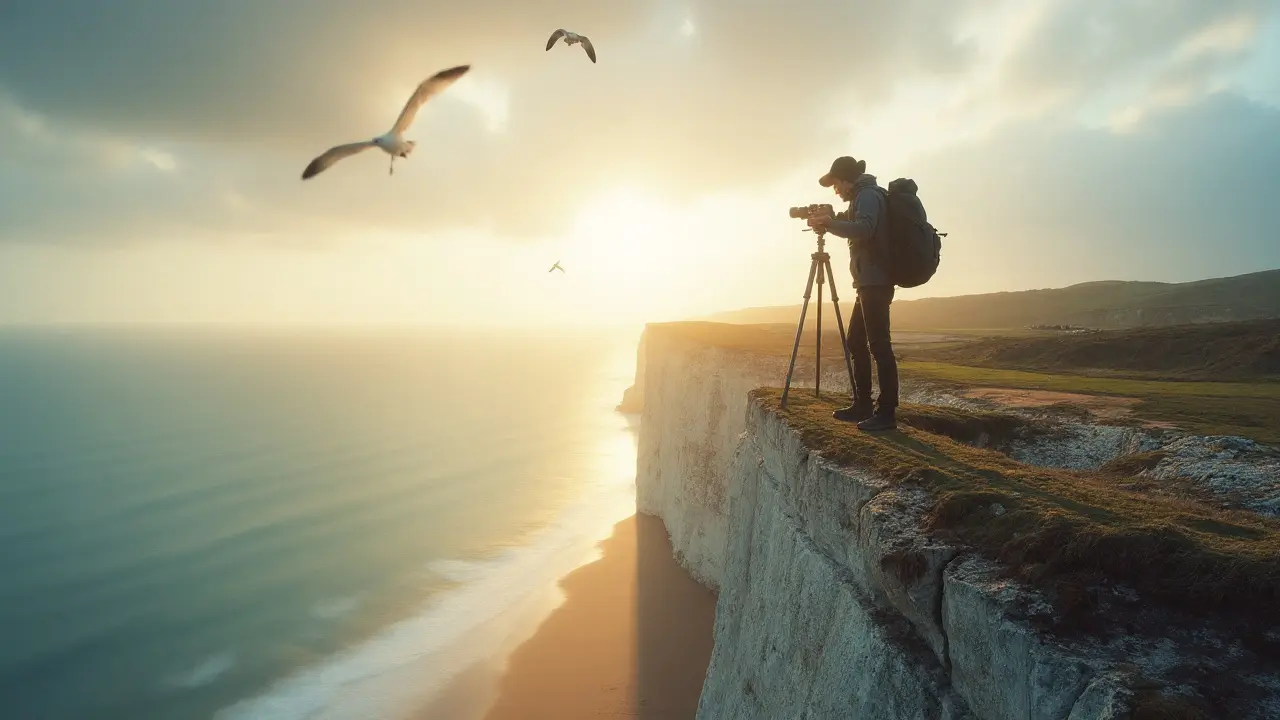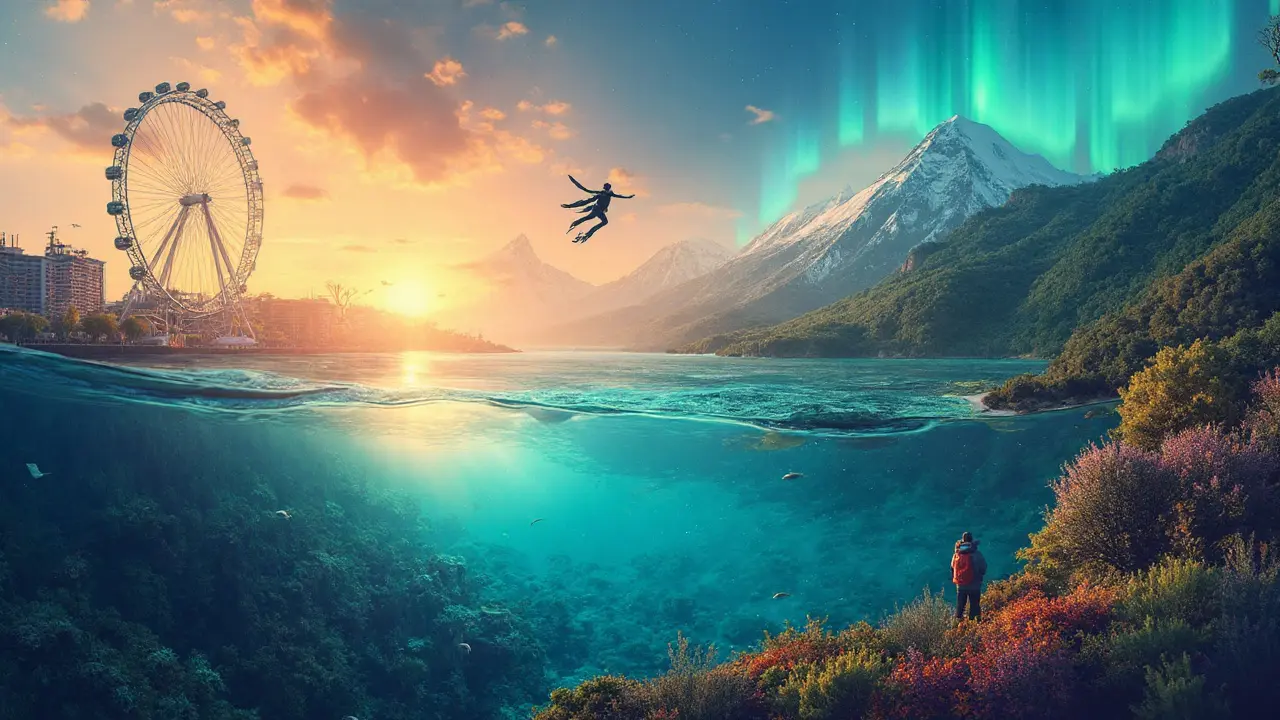From a bench on Primrose Hill in London, you can trace a line from Thames-side wetlands to Arctic tundra, coral reefs, and red desert canyons-without guesswork. This guide shows you where the world’s most dramatic landscapes actually look best from, when to go, and how to plan trips that fit a London schedule and budget. Expect specific viewpoints, realistic timings from Heathrow or St Pancras, and UK-based practice runs so you’re not learning on the fly at 4,000 metres.
- TL;DR: Use London as your hub. Pick an ecosystem, choose a proven viewpoint, travel in the right month, arrive for golden hour, and tread lightly.
- Best quick wins: Seven Sisters for sea cliffs, Walthamstow Wetlands for birdlife, Sky Garden for urban canopy, Eryri (Snowdonia) for alpine-style ridges-no flights needed.
- For long-haul: Red Sea reefs in winter, Jordan’s Wadi Rum in spring, Peru’s Andes + Amazon in May-July, Iceland’s south coast in Sept-Oct.
- Tools that work: Met Office app, OS Maps, PhotoPills, Tide Times UK, Citymapper/TfL Go, National Rail Enquiries.
If you came here for a clean shortlist, here it is: reef outlooks in Egypt’s Ras Mohammed, dune panoramas in Wadi Rum, glacier edges in Iceland’s Skaftafell, cloud forest terraces above Machu Picchu, savannah kopjes in Serengeti, and bog-and-tarn views in Scotland’s Assynt. And in the city: the Sky Garden and Parliament Hill still slap on a clear winter morning.
One more thing: when I say viewpoints, I mean exact places where the land lines up. The right bend, the right ridge, the right rock. Fewer miles, better views.
Mapping the world’s ecosystems from a London base
Start local. London gives you a sampler plate of habitats, perfect for training your eye and your legs before big trips.
- Urban canopy: Free-book the Sky Garden (20 Fenchurch Street). You’ll see the Thames’ curve, St Paul’s dome, and the geometry of the City. Go at weekday sunrise in winter for crisp air and less glare.
- Heath and ancient woodland: Parliament Hill and Kenwood on Hampstead Heath give layered horizons over the skyline. Works a treat in autumn when the oaks pop.
- Wetlands in the city: Walthamstow Wetlands and the London Wetland Centre (Barnes) bring in herons, cormorants, and winter ducks. Great for testing long lenses and patience. Check hide opening times.
- Parks-as-savannah: Red deer in Richmond Park at dawn. Keep distance (RSPB/Natural England guidance: at least 50 m) and stick to paths during rutting season (autumn).
- Botanical time travel: Kew Gardens’ Temperate House and Palm House simulate climates you’ll meet later-alpine, tropical, arid-minus the jet lag.
Near-London practice runs that feel a world away:
- Chalk sea cliffs: Seven Sisters/Birling Gap from Eastbourne or Seaford. Stand on Seaford Head for the textbook head-on view of the undulating cliffs. Check National Tidal and Sea Level Facility times if you plan a beach walk.
- Shingle ‘desert’: Dungeness on the Kent coast-bleak, beautiful, big skies, wild headlands, and abstract textures.
- Downland ridges: Box Hill or Devil’s Dyke on the South Downs for easy sunrise lines and sea haze on clear days.
- Welsh mountains: For a long day or weekend, Eryri (Snowdonia) via London Euston to Bangor, then a bus to Llanberis. Try the Miner’s Track for a high feel without serious exposure.
Now for the world stage. Here are the ecosystems most Londoners chase and the exact spots where they shine. These aren’t random pins; they’re proven angles many photographers and guides use, cross-checked with UNESCO listings, IUCN site notes, and national park maps.
- Coral reefs (Red Sea, Egypt): Ras Mohammed National Park. View from Shark Observatory cliff-reef shelves, cobalt water, and drop-off visible from land. Best Dec-Apr.
- Tropical rainforest + Andes (Peru): Mirador viewpoints on the Inca Trail or Km 104 to the Sun Gate for terraces above cloud forest; add Tambopata or Manu for canopy towers.
- Desert dunes and rock (Jordan): Wadi Rum’s Jebel Khazali area and Um Fruth rock bridge for late-afternoon tones that paint the whole valley.
- Glaciers and black sand (Iceland): Skaftafell’s Sjónarnípa for glacier tongues and Jökulsárlón/Diamond Beach for ice against volcanic shore. Sept-Oct is magic.
- Temperate rainforest and moor (Scotland): Assynt’s Stac Pollaidh ridge looks across lochs to Suilven-otherworldly shapes, often with fast-moving light.
- Savannah and migration (Tanzania/Kenya): Serengeti kopjes near Moru or Maasai Mara’s Lookout Hill; animals move, geology doesn’t-use rocks for scale.
- Alpine lakes and peaks (Switzerland): Männlichen or Schynige Platte above Interlaken for sweeping layers of the Bernese Alps with train access.
- Tundra and ice (Svalbard or northern Norway): Any coastal spur with a safe guide-use wide angles for glacier fronts and distant peaks.
London reality check: direct flights, trains, and ferries decide what’s feasible on a weekend versus a fortnight. Direct winter hops to Hurghada (Red Sea) or Amman (Jordan) beat long connections. The Caledonian Sleeper to the Highlands gets you sunrise on a ridge with zero airport faff.
| Ecosystem & Viewpoint | Where | Best window (2025) | From London (typical) | Notes |
|---|---|---|---|---|
| Reef cliff outlook (Shark Observatory) | Ras Mohammed, Egypt | Dec-Apr | 5h flight LHR-HRG + 1h drive | Good viz in winter; avoid midday glare |
| Desert panoramas (Um Fruth arch) | Wadi Rum, Jordan | Mar-May, Oct-Nov | 5h flight LGW-AMM + 4h drive | Golden hour explodes the reds |
| Glacier views (Sjónarnípa) | Skaftafell, Iceland | Sept-Oct | 3h flight LHR-KEF + 4.5h drive | Stable light, less summer haze |
| Andean terraces (Sun Gate) | Machu Picchu, Peru | May-July | 13h flight (1 stop) + train/bus | Dry season; permits needed |
| Savannah kopjes (Moru) | Serengeti, Tanzania | July-Sept (north) | 11h flight (1 stop) + bush flight | Use rocks for scale; respect distance |
| Temperate rainforest (Stac Pollaidh) | Assynt, Scotland | Apr-June, Sept | 1h30 flight LHR-INV + 2h drive | Changeable; OS Maps essential |
| Sea cliffs (Seaford Head) | Seven Sisters, UK | Apr-Oct | 1h20 train from London | Check tides; keep back from edges |
| Tundra & ice (guided spur) | Svalbard, Norway | June-Aug | 5h flight (1 stop) from LHR | Guides required outside town |

Planning and timing: routes, seasons, and practicalities
Before you book anything, set your aim: a reef ledge at blue hour or a mountain saddle at sunrise? Clarity on that one question drives timing, kit, and budget.
- Choose the ecosystem first, not the country. Landscapes don’t care about borders. If you want crimson dunes, Wadi Rum, the Namib, or the Empty Quarter all work; pick the one with better flights from London and milder temperatures.
- Lock the viewpoint angle. Search for the exact lookout (e.g., Sjónarnípa in Skaftafell, Seaford Head for Seven Sisters). Save offline maps in OS Maps/Google Maps and download a GPX.
- Check season windows. Use the Met Office (for UK trips), national park pages, and tourism boards for rain/dry seasons and daylight. For sunrise/sunset, PhotoPills or the Royal Observatory’s published times do the job.
- Book the thing that sells out earliest. In Peru that’s permits/trains; in Svalbard it’s small-boat spots; in London it’s Sky Garden morning slots on clear days. Flights come next, then local transport.
- Time your light. A good rule: be on location 60-90 minutes before sunrise, 90-120 minutes before sunset. In London’s winter, dawn can be after your commute starts-easy win.
- Plan your exit. Cliff tops and glaciers get sketchy after dark. Bring a headtorch, a spare battery, and a simple bearing in your OS Maps app.
London transport shortcuts:
- Airports: Heathrow and Gatwick have the widest long-haul net; Stansted and Luton cover budget Europe/North Africa; London City is fast for alpine runs via Zurich/Geneva.
- Trains: National Rail Enquiries for live info; Trainline for split tickets; the Caledonian Sleeper for Scotland; Eurostar from St Pancras for Swiss Alps in under 8 hours with one change.
- In-city: TfL Go and Citymapper are best for sunrise missions across London. Night Tube helps you reach Hampstead before the sky glows.
Rules of thumb that save trips:
- Haze: Pick days after a front passes. The Met Office rain radar and pressure charts help you hit the clear window.
- Tides: For sea caves and beach reflections, aim for a spring low tide; Tide Times UK or the Hydrographic Office data is reliable.
- Wind: For drone flyers, 8-12 mph is manageable; above that, rethink. Follow the CAA Drone Code-registration, keep well away from people, and never in restricted airspace.
- Heat and altitude: In deserts, shoot early/late and nap midday. Above 3,000 m in the Andes, slow down, hydrate, and give it a day to acclimatise (NHS Fit for Travel has solid guidance).
Kit you actually need, tested on UK hills and city rooftops:
- Footing first: Lightweight boots with grip for chalk and mud; trail shoes for urban-to-trail days.
- Warmth: A compact insulated jacket-London dawns bite, and high places colder still. Add a thin windproof shell.
- Navigation: OS Maps (download tiles), compass, and a battery bank. Phone-only fails in sleet.
- Lens picks: 24-70 mm covers 90% of scenic work; a 70-200 mm compresses dunes and distant peaks. In cities, 16-35 mm helps with tight spots.
- Filters: A polariser for reefs and wet rocks; a 3-stop ND for smoothing waves. Don’t overdo it-clean glass beats stacked filters.
- Safety bits: Headtorch, basic first aid, whistle, and foil blanket. They weigh the same in London and in Iceland-and matter more in the latter.
Sustainable choices that move the needle:
- Go direct when you can. A single non-stop from London often beats two short hops on emissions and lost time.
- Swap one flight for a sleeper. London to the Highlands or the Alps by train adds views, not just virtue.
- Pack lighter. Less weight, less fuel, fewer fees, faster moves.
- Protect places: Reef-safe sunscreen; no drones near wildlife; keep back from cliff edges and nesting birds (March-July in the UK is sensitive; RSPB advice applies).
Money and time savers Londoners actually use:
- Flex weekends around weather. Hold refundable hotel options; watch the Met Office and pounce midweek for a Saturday blue sky.
- Annual memberships that pay back: National Trust and English Heritage for car parks and access; WWT for wetlands like Barnes.
- Travel insurance that covers mountain and desert activities; read the policy-off-trail or above certain altitudes often needs a named upgrade.

Field notes: itineraries, checklists, and London-savvy tips
Sample itineraries designed for a London calendar and body clock.
48 hours, no plane: Chalk cliffs and city skyline
- Friday evening: Pack, check tides and sunrise; charge batteries; book a Sky Garden early slot if the forecast is clear.
- Saturday: Dawn on Parliament Hill. Brunch in Kentish Town. Train from Victoria to Eastbourne/Seaford. Sunset at Seaford Head; shoot the cliffs with long shadows. Back to London.
- Sunday: Walthamstow Wetlands hides for birdlife; finish at the Sky Garden or the Garden at 120 for a free, no-fuss city panorama.
Long weekend: Iceland’s glacier tongues
- Thursday night: LHR-KEF, pick up a car. Check road.is for conditions.
- Friday: Drive to Skaftafell. Afternoon scout of Sjónarnípa path; sunset on the ridge.
- Saturday: Dawn at Jökulsárlón; ice on Diamond Beach post-sunrise. Back-up spot: Fjallsárlón if wind is up.
- Sunday: Waterfalls on the return (Skógafoss from the staircase viewpoint). Evening flight to London.
One week: Desert rock and sea corals (Jordan + Sinai)
- Day 1-3: London to Amman; Wadi Rum camp. Late and early light at Um Fruth and Khazali. Midday siesta.
- Day 4-7: Aqaba or across to Sinai (check visas and safety guidance on GOV.UK). Land-based reef lookouts near Ras Mohammed; snorkel with a guide if conditions allow.
Two weeks: Andes terraces to Amazon canopy (Peru)
- Days 1-4: Fly to Cusco; acclimatise; Sacred Valley viewpoints above Pisac or Moray.
- Days 5-7: Inca Trail short route to the Sun Gate; terrace views at blue hour.
- Days 8-12: Tambopata canopy tower for dawn bird choruses; river bends for sunset layers.
- Days 13-14: Buffer days for weather and transport; return to London.
Checklists you’ll actually tick:
Viewpoint planning checklist
- Exact coordinates saved (offline)
- Sun angle checked for the month (PhotoPills)
- Weather window and wind (Met Office/Windy)
- Tide or glacier access notes (UK Hydrographic Office; local park advisories)
- Plan B and Plan C locations within 30 minutes
- Transport time with +25% buffer
Carry-on kit for London flyers
- Camera + 2 batteries + 2 cards
- 24-70 mm, polariser, microfiber cloth
- Light down jacket, hat, gloves
- Headtorch, power bank, USB-C cable
- Reusable bottle, snacks, basic meds
- Insurance docs, copies of IDs/permits
Common pitfalls and how to dodge them:
- Arriving at the wrong height: Many viewpoints look best 10-20 metres higher or lower than the car park. Scout early with a lightweight kit.
- Cliff safety complacency: Chalk and sandstone undercut. Stay back, especially at Seven Sisters. Photos aren’t worth a collapse.
- Midday reef glare: Shoot early/late or when thin cloud softens the surface; polariser at 90° to the sun helps.
- Altitude headaches in Cusco: Book your ‘money shot’ on day 3 or 4, not day 1.
- Drone fines in cities: London has controlled zones. Check the CAA map and borough bylaws; many central spots are a hard no.
Mini‑FAQ
- Do I need permits for popular lookouts? Peru’s Inca sites require permits timed to the hour; Wadi Rum needs an entry ticket and a guide for some areas; UK national trusts may need parking reservations on busy weekends.
- What about visas from the UK? Start with GOV.UK foreign travel advice. Some places offer e-visas; apply at least two weeks out.
- Best months if I can only travel in school holidays? Easter: Jordan/Red Sea/Canaries for dry heat and sea views. Summer: Iceland/Scotland/Alps. October half-term: Jordan, Egypt, southern Europe’s coasts.
- Can I get great shots without a drone? Yes. Most classic views were shot from ridges, sea headlands, and towers. Use compression (70-200 mm) and elevation for drama.
- How do I practice in bad London weather? Shoot in drizzle-soft light is forgiving. Bridges (Waterloo, Millennium) are stable platforms; Kew’s glasshouses give warm air and contrast.
Next steps for different travellers
- Busy professional in London: Pick one ecosystem per quarter. Q1: Red Sea cliff views. Q2: Scottish Highlands by sleeper. Q3: Alps by Eurostar. Q4: Desert in Jordan.
- Family with school-age kids: Seven Sisters day trip; WWT Barnes for hides; Swiss Alps in summer via train for car-free villages; Iceland in late August for kinder weather.
- Budget-first: Use advance rail fares for UK spots. Aim for Red Sea/Jordan shoulder seasons. Share car hires; carry picnic gear, not restaurant tabs.
- Photographer chasing a portfolio: Limit to two hero locations per trip. Arrive early, accept repeats, and leave space for weather to turn.
Credibility notes: Dates and seasonality align with UK Met Office climate normals, Icelandic road advisories, and park authority guidance; wildlife distances reflect RSPB and Natural England advice; health info aligns with NHS Fit for Travel; visa timing follows GOV.UK guidelines; drone rules follow the UK Civil Aviation Authority’s Drone Code; world site status cross-checks against UNESCO and IUCN listings. If a ranger, guide, or tide table says “not today”, it’s not today.
One last nudge: you don’t need to chase every horizon in a year. From London, you can get world-class ocean cliffs before lunch and still make a dusk slot in the City. Start small, plan well, and leave room for luck-the light tends to reward the people who showed up early.
Oh-and mark this down once, then forget the hype: the hard part isn’t finding scenic viewpoints. It’s giving yourself the right hour at the right place. The rest is just trains, tides, and a bit of tea in a Thermos.





